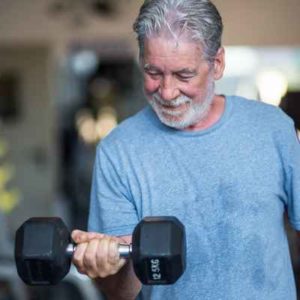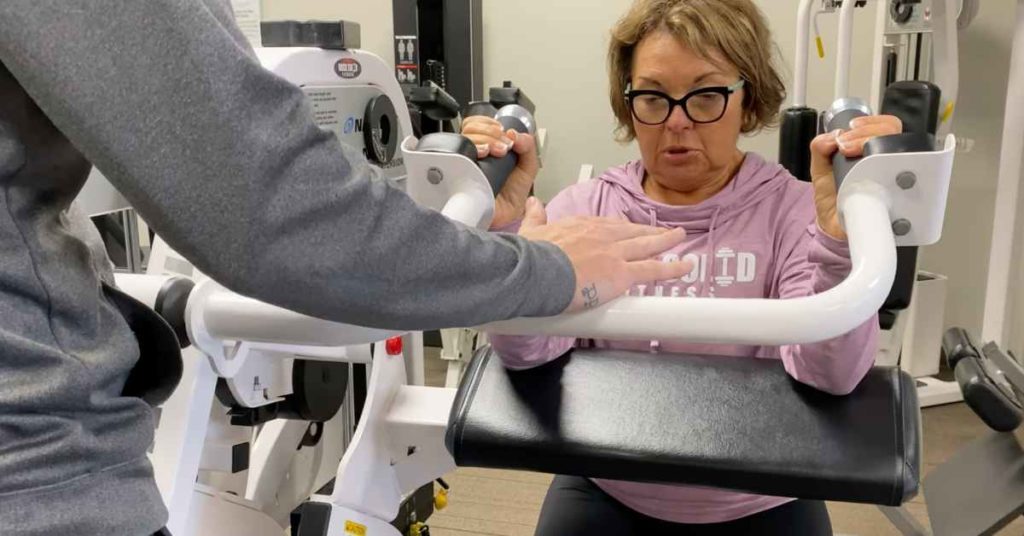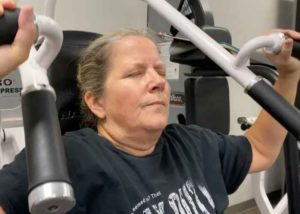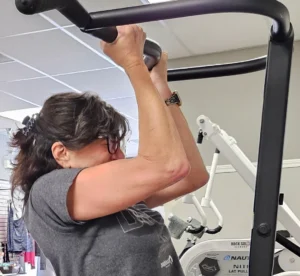As we age, it’s important to make bone health a priority. Our bones are constantly renewing themselves, but this process slows down as we get older, which can lead to a higher risk of osteoporosis and fractures. And while bone loss may be a natural part of aging, there are steps we can take to help maintain strong bones and prevent osteoporosis.
Even better – we’re here to let you know the really good news is that strength training can help prevent and treat osteoporosis.

What is Osteoporosis?
Osteoporosis is a serious condition that affects millions of people every year. This disease is characterized by low bone mass and microarchitectural deterioration of bone tissue. This can lead to enhanced bone fragility and increased fracture risk. According to the Surgeon General’s Report on Bone Health and Osteoporosis, one in two women and one in four men aged 50 years or older will have an osteoporosis-related fracture in their lifetime.
So let’s look at just how strength training is badass for your bone health.
The Greatest Osteoporosis Risk
Women are the greatest risk group for developing osteoporosis. The Bone Health and Osteoporosis Foundation reported that women can lose up to 20% of their bone mass in the 5-7 years after menopause. This is due to the drop in estrogen levels that occurs during the menopausal transition period. Estrogen is essential for maintaining strong bones and preventing bone resorption. Without adequate estrogen levels, bones will begin to lose density, making them more susceptible to fractures.
Smaller-framed women are especially vulnerable to developing osteoporosis due to their lack of weight-bearing bone mass. Astronauts returning to Earth after spending time in space often suffer from bone fractures due to the lack of weight-bearing while in space. Without weight bearing, bones will decrease in density and muscles will decrease in strength and size. Small-framed women have less weight to bear and can further increase their risk for developing osteoporosis. Although osteoporosis is a serious condition, there are steps that women can take to prevent or slow its progression. First, let’s chat calcium.
Osteoporosis and Calcium: Old Myths Die Hard
Calcium, calcium, calcium. It’s the first thing that comes to mind when we think about osteoporosis prevention. We’ve been led to believe that if we just eat foods high in calcium or take supplements, we’ll be well on our way to strong bones. But what we’re not told is that this isn’t enough for those at high risk of osteoporosis. A global view of fracture epidemiology shows that low calcium intake regions (such as Africa and Asia) have historically had lower fracture rates than regions where dairy products form an important part of their diet. This means that there’s more to osteoporosis prevention than just calcium.
There’s no denying that calcium is important for strong bones. But recent studies have called into question the need for calcium supplements, particularly for older adults. While calcium supplements have been found to have an initial benefit in terms of increasing bone density, the associated risks may not make them worth taking on a long-term basis. In addition to causing constipation, bloating, and kidney stones, calcium supplements may also increase the risk of myocardial infarction.
For individuals who are already deficient in calcium, supplementing may be necessary in order to prevent osteoporosis. However, for those who are not deficient, it is unlikely that calcium supplementation will provide any significant benefits. Similarly, while vitamin D supplementation is important for those who are deficient in this nutrient, it is unlikely to provide any benefits for those who are not deficient.
The Vitamin D Debate: To Supplement or Not to Supplement
There’s been a lot of debate in recent years about the benefits of vitamin D supplements. Some claim that vitamin D is essential for good health, while others argue that it is not necessary unless you are deficient in vitamin D. So, what is the truth? The truth is that vitamin D supplements are only necessary for those who are deficient in vitamin D.
In 2012, the U.S. Preventive Services Task Force issued new recommendations saying there was not enough evidence to recommend taking calcium or vitamin D supplements and recommending against it in some cases. However, if you are at risk for osteoporosis, your doctor may recommend taking a vitamin D supplement. The bottom line is vitamin D supplements may only be necessary if you are deficient in vitamin D or if you are at risk for osteoporosis.
Osteoporosis Medications: Are the Side Effects Worth It?
While there are many different medications available to treat osteoporosis, it’s important to weigh the pros and cons of taking the medication before starting any treatment. The side effects of osteoporosis medications can be difficult to manage, and they may not be worth it for some people.
Osteoporosis medications can be broken down into two groups: antiresorptive drugs, which slow down the rate at which your body breaks down bone; and anabolic drugs, which increase bone formation. Depending on the drugs, common side effects are nausea, heartburn, stomach pain, fever, chills, skin issues, pain in muscles or bones, and more. Therefore, osteoporosis medications should be used as a last resort after all other options have been exhausted.
If medications are necessary, it is important to speak with a doctor about the potential risks and benefits. By understanding the risks and benefits, patients can make informed decisions about their treatment.
 The Best Way to Prevent Osteoporosis: Exercise
The Best Way to Prevent Osteoporosis: Exercise
When it comes to osteoporosis, exercise is often lauded as the best prevention method – and for good reason. Strength training and resistance training help to increase bone density and prevent bone loss, both of which are key in osteoporosis prevention.
However, not all exercise is created equal. In fact, there are a few myths surrounding exercise and osteoporosis that it’s important to dispel. For example, some people believe that you have to start exercising at a young age to see benefits later on in life. However, research has shown that it’s never too late to start strength training and resistance training – even if you’ve already been diagnosed with osteoporosis.
What You Need to Know About Strength Training and Resistance Training for Preventing Osteoporosis
Also, carrying a pair of 5-pound dumbbells around the neighborhood doesn’t meet the minimum requirement for weight-bearing, resistance training exercise. To be effective, strength training must put significant stress on the bones to trigger an adaptive response.
Excellent choices for osteoporosis prevention are strength-training activities that involve lifting weights or working against resistance. These activities help to build bone mass and maintain muscle strength, both of which are essential in preventing osteoporosis. So, if you’re looking to prevent or manage osteoporosis, don’t hesitate to start strength training and resistance training today.
Strength Training Helps Build Bone Density
It’s true! Strength training is great for bone health! Just ask those folks with a whole lot of initials: National Center for Biotechnology Information (NCBI), National Library of Medicine (NLM), and the National Institutes of Health (NIH). One of the most important benefits of resistance training for osteoporosis is that it helps build bone density. Our bones naturally start to lose density as we age, which can lead to osteoporosis. We covered this already. However, strength-training exercises help stimulate the production of new bone cells, which can help slow down or even prevent the onset of osteoporosis.
 Strength Training Improves Balance and Coordination
Strength Training Improves Balance and Coordination
Another benefit of resistance training for osteoporosis patients is that it can help improve balance and coordination. Many older adults begin to experience balance problems as they age, which can lead to falls and fractures. Strength-training exercises help improve muscle strength and coordination, which can, in turn, help improve balance and reduce the risk of falls. Hello, second glass of wine.
Strength Training Increases Muscle Mass
In addition to increasing bone density and improving balance and coordination, resistance training also helps increase muscle mass. This is especially beneficial for older adults because muscle mass naturally starts to decline with age.
However, resistance exercises help stimulate the growth of new muscle cells, which can help offset age-related muscle loss. Increased muscle mass can also improve metabolism and insulin sensitivity, which is critical for preventing osteoporosis.
Strength Training at Rock Solid Fitness in Dunedin
Rock Solid Fitness is a Clearwater gym that offers an exercise program that has been successful in helping people battle osteoporosis. We use equipment that limits all unnecessary risk factors, so you can leave those behind and just get the benefits. Another important focus of our exercise program is focusing on the most important exercises to make your program efficient and avoid wasting time. Some of these exercises include the leg press, shoulder press, low back extension, chest press, and pulldown.
These exercises are compound exercises that involve many muscles and bones, in particular, the bones that are at the highest risk of being affected by osteoporosis. Every exercise performed at Rock Solid Fitness is supervised by college-educated fitness professionals who are certified in CPR/AED and have extensive knowledge in anatomy and physiology.
Strength Training for Bone Health
By making bone health a priority at any age, we can decrease the likelihood of developing osteoporosis. Whether you’re just starting to think about your bone health or are already experiencing symptoms of osteoporosis, strength training can be a valuable tool in improving and maintaining bone strength. At Rock Solid Fitness in Dunedin, our team of trainers can work with you to design a resistance training program tailored to your specific needs and abilities.
Don’t wait until it’s too late – start strengthening those bones today!




 The Best Way to Prevent Osteoporosis: Exercise
The Best Way to Prevent Osteoporosis: Exercise Strength Training Improves Balance and Coordination
Strength Training Improves Balance and Coordination
